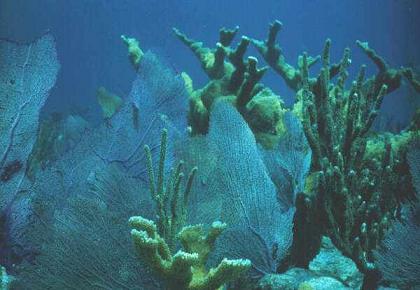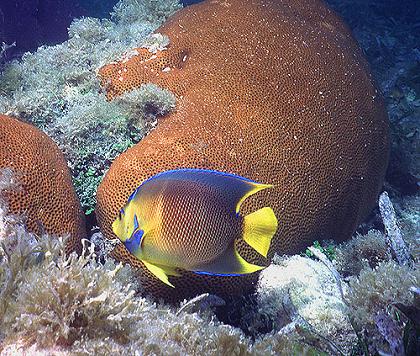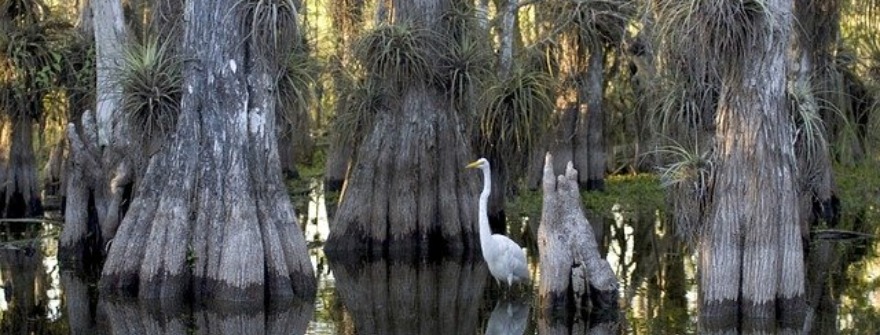The peninsula state in the southeastern part of the USA, Florida is the land of beaches and unlimited entertainment. Home to Walt Disney World Resort, one of its kind recreational resorts in the entire globe, Florida thrives on tourism, its biggest industry. Its nickname, the sunshine state, is a perfect reflection of the life here, sunny all the time. Being close to the ocean bestows a large part of Florida with a humid subtropical climate. The trademark glittering white sand beaches of Florida are admired the world over for their natural splendor and amenities.
Biscayne National Park, Florida
Biscayne National Park is located just south of Miami along the extreme southeastern coast of Florida. This park is an outdoor lover’s paradise, where fishing, snorkeling and diving dominate. The blue waters of the bay, the fish and other marine animals, subtropical vegetation, and spectacular sunsets make this a great place to visit.

The main portion of the park on the mainland is at Convoy Point approximately 10 miles west of Homestead, Florida. Convoy Point is the site of a brand new visitor’s center. Terrific untainted areas include the Florida Reef, a great band of living coral just a few miles off the coast. The protected John Pennekamp Coral Reef State Park is one of the most beautiful collections of living coral reef in the world.
Even from a glass-bottom boat, you can spot lobsters, angelfish, eels and jellyfish along the reef. The reef itself is a delicate living thing, comprising millions of minute coral polyps extracting calcium from the seawater. Sadly, its quite easy to spot dead coral also: white patches show where a careless diver may have scraped away the protective layer and left the coral susceptible to a terminal disease.
Crandon Beach is one of the finest landscaped beaches in this region, with crystal clear waters and sports facilities. Three miles of yellow-brown beach fringe the park, and give access to a sand bar enabling knee-depth wading far from shore. An excellent swimming beach lines the Atlantic-facing side of the park, and a boardwalk cuts around the wind-bitten sand dunes.
Dry Tortugas National Park, Florida
Dry Tortugas is one of the smallest, one of the most remote, and one of the least visited national parks in the United States. Comprising seven small islands with coral reefs and other undersea attractions, this is an outdoor lover’s paradise. The park comprises a cluster of seven islands, almost 70 miles west of Key West. Of the 100 square miles which makes up the park, less than a single square mile is believed to be above water.

Untainted natural areas include the Florida Reef, a band of living coral just a few miles off the coast. Much closer to Cuba than to mainland Florida, this region often seems rather tenuously bound to the rest of the US. Even so, the sense of isolation is best appreciated by walking through the gorgeous, lushly vegetated trails.
The Florida Keys visitor center provides information on local accommodation, diving, and other attractions. Visitors can enjoy the beautiful lagoons with their natural beach and pristine, clear ocean waters, which can be enjoyed on a leisurely kayak ride. You can almost feel urban stresses and strains slip away as you take in the deep blue sea and waving palms.
The climate in the Tortugas is ideal for visiting year-round. Warm sunshine and blue skies are almost always a fact of life here. During the Florida summer, the crowds arrive, and the days tend to get hot and sticky. Also, there is a potentially ominous time of the year, from June to November – the hurricane season.
Everglades National Park, Florida
Everglades National Park is one of the largest and most well-known of America’s national parks. It bestows federal protection to a comparatively small section around Florida’s southeastern corner. In the park, the vital links holding the Everglades together are seen everywhere: the cycle of wet and dry seasons, the tree islands that provide protection to animals, and the fishing colonies.

DeSoto National Memorial
The mission of the De Soto National Memorial is to commemorate Spanish explorer Hernando de Soto, who landed on the southwest Florida coast in 1539. With an army of 600 soldiers, Soto had come to the new world with a license from the King of Spain to explore, colonize and pacify the Indians of the area known as “La Florida”. The expedition faced many hardships throughout the four-year, 4000-mile journey. Programs at the park explain the prevailing 16th-century Spanish cultural values and the inevitable clash with the native cultures the expedition encountered. This expedition was the first large scale European mission into the interior of North America. Survivors of the expedition reported the abundance of rich natural resources found in “La Florida”.
From late December to early April, Camp Utica, a reproduction of the 16th Century Indian village that the Soto expedition used as a base camp, is open. Park rangers dressed in period costume give demonstrations of blacksmithing, cooking, armor repair, and military weapons of the period. Of special interest is the firing of a military crossbow, and an Arquebus – a primitive black powder weapon that predates the flintlock. The visitor center has a twenty-one-minute film entitled, “Hernando De Soto in America”, and is shown throughout the day. This film depicts the four years, the 4000-mile journey of Soto and his men, throughout what is now the southeastern United States. The visitor center offers museum exhibits that relate the story of the expedition and its impacts upon Native Americans and Florida. Included are 16th-century artifacts such as armor, weapons, examples of Indian pottery, and projectile points. Detailed maps trace the route of the expedition, highlighting significant incidents and features. An outdoor exhibit on the north porch shows probable archaeological sites associated with the four-year trek.
Ocala National Forest
Comprised of 383,220 acres, the Ocala National Forest receives more visitors than either of the other two national forests located in Florida. Towering palms, large live oaks, and sand pine dominate the landscape in the drier sections of the forest, while hardwoods thrive beside longleaf and slash pine in the areas with more moisture. The vast variety of ecosystems in the park combined with its wonderful trail system make it especially delightful for hiking. Possibly the greatest variety of plant and animal species can be observed along the Florida National Scenic Trail, 65 miles of which run through the Ocala National Forest. Most of the campgrounds in the park contain hiking trails within their boundaries, and the trails offer focal points as varied as bubbling springs and wildlife observation platforms.
Four major springs are located within the forest, making it a great place to swim, dive, snorkel and canoe. Alexander, Salt, Juniper and Silver Glen Springs all have wonderful swimming areas, and snorkeling and spring diving give the visitor an underwater view of a unique ecosystem. In addition, all of the springs have runs (streams), which offer some of the best canoeing in Florida. Crystal clear water flows swiftly through tropical wilderness on all the spring runs, and they vary in length from one to seven miles. For a longer canoe trip, the Upper Oklawaha River offers the visitor a chance to paddle a real Florida blackwater river. The entire canoe run takes two full days; with four different take-out points along the river the trip can be reduced. Eleven developed campgrounds offer the camping enthusiast unlimited options. Ten of the developed sites offer full RV hookups, and the campgrounds range in size from 14 to 197 individual campsites. Bathroom facilities with hot showers, picnic areas and concessionaires are available at most of these facilities. For those who wish to rough it, primitive backpack camping is available throughout the forest, with a permit from the main office. Several of the trails also have primitive campsites with water along their paths. The other recreational opportunities in Ocala National Forest include 100 miles of horse trails, a twenty-two-mile bicycle trail, fishing, and limited hunting with permits.
What are the National Parks in Florida
The United States has a massive national park system. So, what are the national parks in Florida? The following list of national parks in Florida is arranged in a particular format. First, the parks are in alphabetical order. Second, the general location is listed, but keep in mind some parks move beyond the borders of Florida. Third, the type of national park is also listed.
Big Cypress National Preserve
Ochopee, FL
National Preserve
Biscayne National Park
Miami, Key Biscayne & Homestead, FL
National Park
Canaveral National Seashore
Titusville and New Smyrna Beach, FL
National Seashore
Castillo De San Marcos National Monument
St. Augustine, FL
National Monument
De Soto National Memorial
Bradenton, FL
National Memorial
Dry Tortugas National Park
Key West, FL
National Park
Everglades National Park
Miami, Naples, and Homestead, FL
National Park
Fort Caroline National Memorial
Timucuan Preserve; Jacksonville, FL
National Memorial
Fort Matanzas National Monument
St. Augustine, FL
National Monument
Gulf Islands National Seashore
Gulf Breeze, Florida and Ocean Springs, Mississippi , FL,MS
National Seashore
Timucuan Ecological & Historic Preserve
Jacksonville, FL
Ecological & Historic Preserve
What national parks are in Florida? Now you know. So get off your derriere and go check them out!
